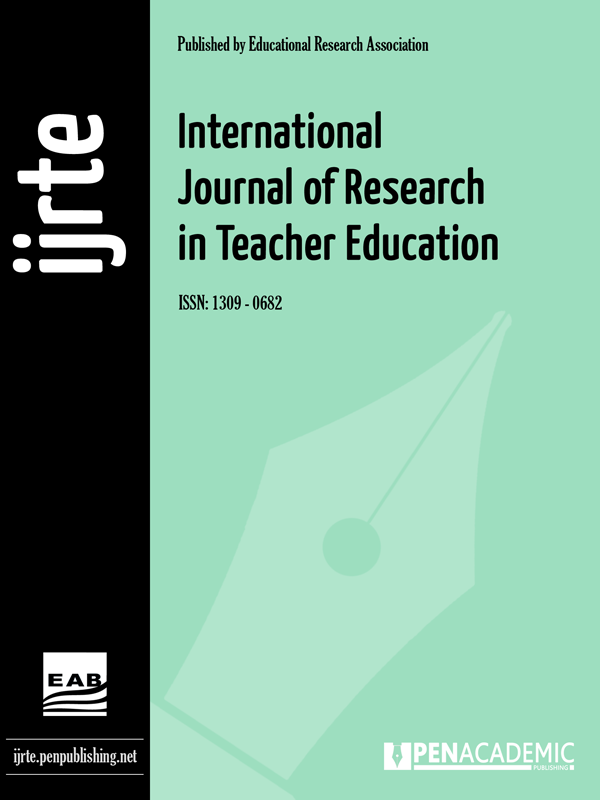Research article | Open Access
International Journal of Research in Teacher Education 2022, Vol. 13(4) 22-31
3-E Enjoy English Effectively Method: The Implementation of Active Learning and Computer Assisted Language Learning in a Secondary School as a New Blended Method
pp. 22 - 31
Publish Date: December 28, 2022 | Single/Total View: 271/409 | Single/Total Download: 400/634
Abstract
Attracting the attention of students in the 21st century is challenging as the students require to be more active in the learning process. For that reason, teachers should use more interesting methods and techniques to make the learning process more effective and enjoyable. With this aim, in this study, active learning and computer-assisted language learning in English language teaching lessons were used together to increase the academic success of students in English classes. The study lasted 8 months. The new method included 11 different activities. 60 4th and 5th-grade students participated in the study. They are willing and motivated to participate in the lesson. The research is mixed research which includes both qualitative and quantitative methods. While pre-speaking tests and post-speaking tests are quantitative methods, observation reports and satisfaction questionnaires were qualitative methods. Initially, the English level of the students was A1 and at the end of the study, their English levels increased to A2. The data were collected through pre-speaking tests; post-speaking tests; a satisfaction questionnaire for the students Moreover, the researchers used the observation method to take notes of the feelings and behaviors of the students. The researchers used a speaking rubric and observation report checklist to analyze the data. The results of the study showed that the method is effective for students in the learning process. It was observed that while learning English, the students were motivated and willing to learn as a result of the conducted activities. According to the results of the speaking exams, the students' scores increased from 35 to 85. Moreover, students stated that they learned better by web 2.0 tools while doing activities during the lesson
Keywords: English language teaching, active learning, computer-assisted learning, computer-assisted language teaching
APA 7th edition
Kaydet, T.B., Bektas, O.S., & Dobromir, A. (2022). 3-E Enjoy English Effectively Method: The Implementation of Active Learning and Computer Assisted Language Learning in a Secondary School as a New Blended Method. International Journal of Research in Teacher Education, 13(4), 22-31.
Harvard
Kaydet, T., Bektas, O. and Dobromir, A. (2022). 3-E Enjoy English Effectively Method: The Implementation of Active Learning and Computer Assisted Language Learning in a Secondary School as a New Blended Method. International Journal of Research in Teacher Education, 13(4), pp. 22-31.
Chicago 16th edition
Kaydet, Tugba Bademci, Ozgen Sahin Bektas and Anda Dobromir (2022). "3-E Enjoy English Effectively Method: The Implementation of Active Learning and Computer Assisted Language Learning in a Secondary School as a New Blended Method". International Journal of Research in Teacher Education 13 (4):22-31.
- Alves M. (2015). Ways to apply active learning in the college ESL classroom. College ESL Quarterly Spring 2015. [Google Scholar]
- Attaran A., Gholamı V. & Moghadda M. M. (2014). The effects of active learning on foreign language self-concept and reading comprehension achievement. International Journal on New Trends in Education & Their Implications (IJONTE) 3(4). [Google Scholar]
- Bonwell, C. C., & Eison, J. A. (1991). Active learning: Creating excitement in the classroom. ASHE-ERIC Higher Education Report No. 1. Washington, DC. [Google Scholar]
- Çakır (2016). The Use Of Video As An Audio-Visual Materıal In Foreign Language Teaching Classroom. The Turkish Online Journal of Educational Technology – TOJET October 2006 ISSN: 1303-6521 volume 5 Issue 4 Article 9 [Google Scholar]
- Derakhshan, A., Salehi, D., & Rahimzadeh, M. (2015). Computer-assisted language learning (Call): Pedagogical pros and cons. International Journal of English Language and Literature Studies, 4(3), 111-120. [Google Scholar]
- Du, X. 2011. On the multimedia teaching in college English listening. Theory and practice in language studies, Vol 1, No 7, 912-914. [Google Scholar]
- Er, M., Altunay,U., &Yurdabakan, İ. (2012). The effect of active learning on foreign language self-concept and reading comprehension achievement. International Journal on New Trends in Education and Their Implication, 3(4), 43-58. [Google Scholar]
- Eslit, E. (2014). Computer-Assisted Language Teaching: Learning Without Dust. Retrieved from https://www.academia.edu/11536522/COMPUTER_ASSISTED_LANGUA E_TEACHING_LEARNING _WITHOUT_DUST [Google Scholar]
- Forster, E. (2006). The value of songs and chants for young students. Journal of research and Innovation in the Language Classroom, 63-68. [Google Scholar]
- Gunduz, N. (2005). Computer-assisted language learning. Journal of Language and Linguistics Studies, 1(2), 193–214. [Google Scholar]
- Han N. V. & Rensburg H. V. ( 2014 ).The Effect of Computer Assisted Language Learning (CALL) on Performance in the Test of English for International Communication (TOEIC) Listening Module. [Google Scholar]
- Liuzhi, Y. ( 2012). On the Applications of Multimedia in English Teaching in Vocational Colleges. Lecture notes in Information Technology, 16-17, 1-4 [Google Scholar]
- Mynard, J. and Sorflaten, R. 2003. Independent Learning in Your Classroom [online]. [Google Scholar]
- Rahnavard F. & Davood M. H. (2019). Impact of Computer–Assisted Language Learning (CALL) /Web-Based Instruction on Improving EFL Learners’ Pronunciation Ability. [Google Scholar]
- Simpson A(2015). Using Games in the Language Classroom. Smashwords Edition License Notes. Retained from: http://research.sabanciuniv.edu/26774/1/using-games-in-the-language classroom.pdf [Google Scholar]
- Thurairaj, J. S., Mangalam, C. & Marimuthu, M. 1991. Multiple intelligences and multimedia in the ESP classroom: The rural-urban distinction, 763-770. [Google Scholar]
- Timuçin M.(2006) Implementing CALL in an EFL context. ELT Journal, Volume 60, Issue 3, Pages 262–271. [Google Scholar]
- Warschauer M.(1996). Computer-Assisted Language Learning: An Introduction. In S. Fotos (Ed.), Multimedia language teaching (pp. 3-20). Tokyo: Logos International. [Google Scholar]
- Yin, R. K. (2003). Case study research: Design and methods (3rd ed.). Thousand Oaks, CA: Sage. [Google Scholar]
- Zewdu K.Y. (2017). Active learning in teaching English language support courses to first-year students in some Ethiopian universities (Unpublished doctoral dissertation). The University of South Africa. [Google Scholar]
